Trying to decide between the 25-06 vs 30-06 Springfield cartridges? Here’s what you need to know about them.
I think most hunters would agree the legendary 30-06 Springfield is an excellent all-around hunting cartridge. While it does indeed offer many advantages to hunters, it’s not perfect. Indeed, cartridges like the 25-06 Remington handily outperform the old 30-06 in some areas.
Both the 25-06 and 30-06 are effective cartridges with loyal fan bases. Statements like the one above are hard for some dedicated 30-06 fans to stomach and the 25-06 vs 30-06 debate can be pretty fierce. With this in mind, important details about their performance unfortunately are misunderstood, overlooked, or simply lost in the shuffle. For those reasons, many people get confused about the strengths and weaknesses of the two cartridges, particularly when discussing which cartridge is best for hunting particular animals under specific conditions.
In this article, I investigate the 25-06 vs 30-06 debate in detail and provide some insight into which cartridge is ideally suited for most common hunting situations so you can make an informed decision on which one will work best for your individual needs.
Before we get started, I have an administrative note for you.
Some of the links below are affiliate links. This means I will earn a small commission (at no extra cost to you) if you make a purchase. This helps support the blog and allows me to continue to create free content that’s useful to hunters like yourself. Thanks for your support.
Additionally, I recorded an entire podcast episode on this exact subject. If you’d rather listen than read, click the appropriate link below to listen to this episode on your preferred podcasting service.
30-06 vs 25-06 Podcast
Apple | Google | iHeart | Pandora | Spotify
History Of The 25-06 Remington and 30-06 Springfield
The U.S. Army decided it needed a new rifle cartridge to replace the .30-40 Krag and .45-70 Government cartridges used by American Soldiers in the Spanish American War. While the United States was victorious in the fight against Spain in 1898, the Army suffered heavy casualties at the hands of Spanish troops in Cuba armed with Mauser rifles chambered in ballistically superior 7mm Mauser.
With that in mind, Army leadership wanted a new infantry service rifle that could compete with the revolutionary new Mauser rifle. Among other things, they were looking for a new bolt-action rifle designed from the start with a stronger action capable of safely firing more powerful smokeless ammunition, with a “claw” extractor for more reliable feeding and extraction, and that could be quickly loaded with 5-round stripper clips.
In the end, the new 1903 Springfield rifle was modeled heavily on (some might even say copied) the 1893 Spanish Mauser rifle. The new rifle was originally chambered in the .30-03 Springfield cartridge, which fired a 220gr round nosed bullet at approximately 2,300fps.
While the new .30-03 cartridge did provide a modest improvement in performance over the .30-40 Krag, the Army still wasn’t completely happy with the performance of the cartridge.
For this reason, designers made a few tweaks to the design of the .30-03 Springfield. Switching over to a revolutionary new 150gr “spitzer” (pointed) bullet fired at a muzzle velocity of 2,700 fps gave them the results they were looking for.
Named both after the year it was formally introduced and the Springfield Armory where it was designed, the high velocity .30-06 Springfield was a significant improvement over previous military cartridges used during that era.
In addition to extensive use with the U.S. military through both World Wars in the 1903 Springfield, 1917 Enfield, and M1 Garand rifles, the .30-06 Springfield cartridge also rapidly caught on with the big game hunting and shooting communities in the United States during the early 20th Century.
The old .30-06 remains one of the most popular centerfire rifle cartridges used by hunters and shooters in the United States (as well as many other parts of the world) to this day.
At the same time, wildcatters and gun designers started modifying the .30-06 for more specialized tasks almost as quickly as hunters started using the new cartridge. Some of these new cartridges based on a modified 30-06 case disappeared quickly, but others (like the .270 Winchester, and .35 Whelen) have stood the test of time and remain outstanding hunting cartridges.
Adolph Otto Niedner (better known as A.O. Niedner) created the .25 Niedner in 1920 by necking the .30-06 Springfield case down to use .257″ bullets. The .25 Niedner did offer a modest improvement in ballistics over the .30-06, but the new .25 caliber cartridge was far too overbore and could not reach its full potential with the powders available at the time.
For that reason, the .25 Niedner was pushed aside by other quarter bore cartridges like the .257 Roberts and the .250-3000 Savage that propelled .257″ bullets at a similar velocity, but used a much shorter case. The fact that the .25 Niedner was still a wildcat cartridge and that no mass produced rifles were available in that chambering didn’t help either.
However, the introduction of slower burning powders like IMR-4350 and H-4831 (originally obtained from surplus 20mm Oerlikon shells) after World War II changed the game completely and allowed handloaders to maximize performance of the .25 Niedner.
Designers at Remington knew a good thing when they saw it and the company standardized the cartridge as the .25-06 Remington in 1969. The company started manufacturing the Remington Model 700 rifle in .25-06 and rolled out two factory .25-06 loads that same year: an 87 grain bullet at a blazing fast velocity of 3,500 feet per second (2,367 ft-lbs of energy) and a 120 grain load at 3,220 feet per second (2,763 ft-lbs of energy).
Deer and antelope hunters in particular loved the accuracy, high velocity, flat trajectory, modest recoil, and impressive terminal performance of the new cartridge with heavier bullets on medium game in North America. It also gained a great reputation as an outstanding varmint hunting round when using lighter bullets.
30-06 vs 25-06 Cartridge Sizes
You can see similarities and differences between the 25-06 Remington and 30-06 Springfield in the photos below.
The shared heritage of the .25-06 and .30-06 is obvious and the two cartridges are identical up to the shoulder. They also share the same 17.5 degree shoulder angle.
Both cartridges also have the same case length and the same .473″ rim diameter.
Though the .30-06 Springfield cartridge in the photo is slightly shorter than the .25-06 cartridge, the 30-06 actually has a longer SAAMI maximum authorized overall length of 3.34″ (84.84mm) vs just 3.25″ (82.6mm) for the 25-06.
However, the two cartridges are close enough in size that both cartridges are used in standard/long-action rifles.
The end result is that the two cartridges have very similar case capacities. The 30-06 can often hold a tiny bit (~5%) more powder than the 25-06, but that’s a very small difference that can change by going from one manufacturer to another.
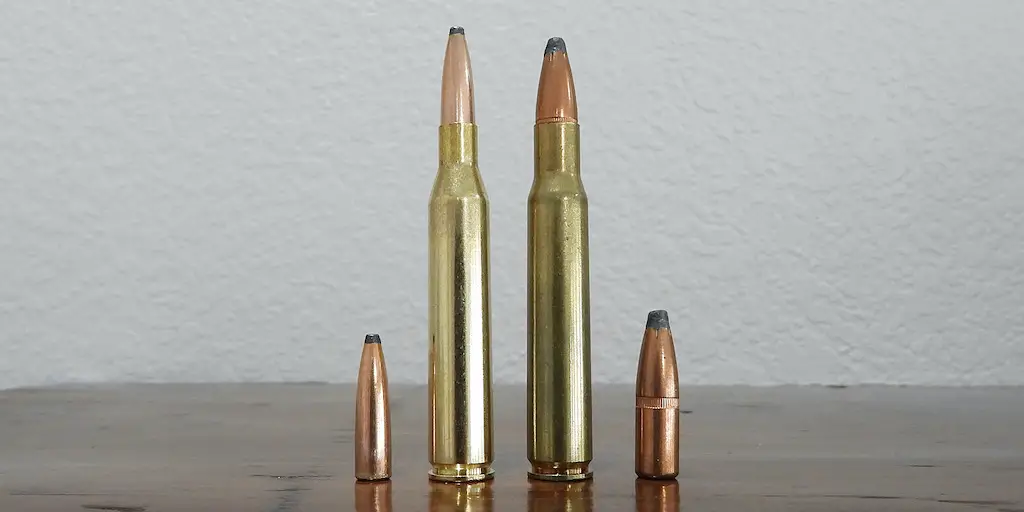
Bullet size and bullet weight are other important differences between the 25-06 vs 30-06. The .25-06 Remington uses .257″ diameter bullets while the .30-06 Springfield uses larger .308″ bullets.
The vast majority of 25-06 factory loads shoot bullets in the 90-120 grain range, with 90 grain, 100 grain, 110 grain, 117 grain, and 120 grain bullets being the most popular.
On the other hand, though it’s possible to find .30-06 ammo shooting bullets in the 110-220 grain range, most .30-06 Springfield factory loads use 150 grain, 165 grain, 180 grain, or 200 grain bullets.
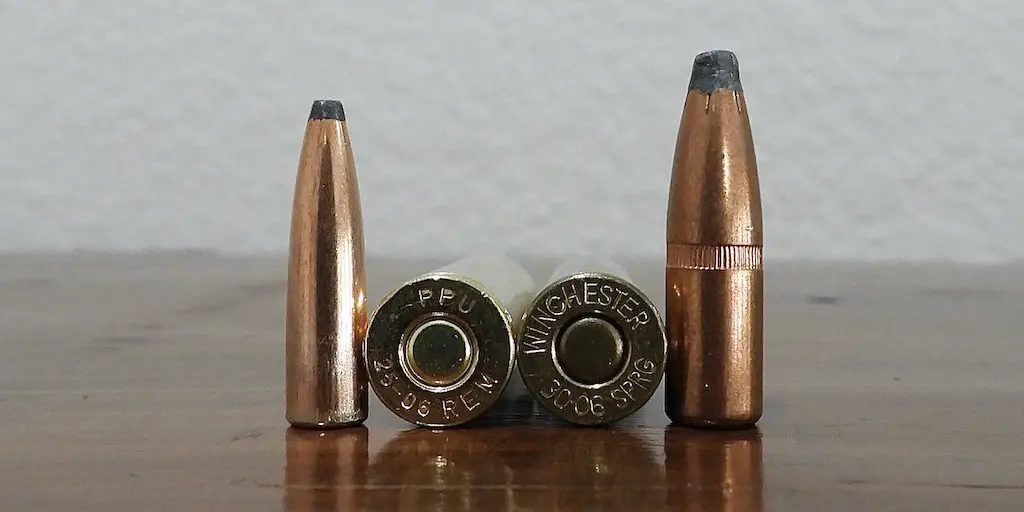
Finally, the 25-06 Remington is loaded to a higher SAAMI maximum average pressure of 63,000psi vs just 60,000psi for the 30-06 Springfield.
Note: while the powder capacity figures listed below do give a good indication of the differences between the two cartridges, exact case capacities vary slightly according to the brand of brass used.
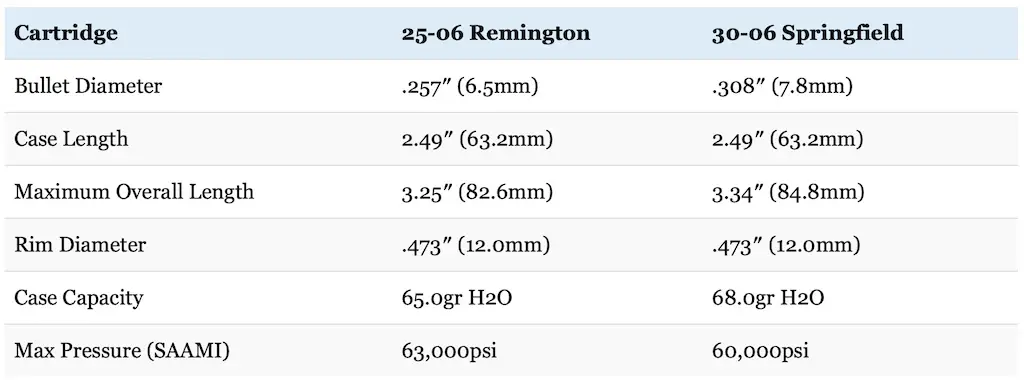
25-06 vs 30-06 Ballistics
The differences in the external dimensions of these cartridges also translate into some stark differences in their ballistic performance. This is illustrated in the table below comparing Federal Premium Rifle and Remington Core Lokt factory ammunition.
The 25-06 Remington loads use 100gr Ballistic Tip (.394 BC) and 120gr Core Lokt (.362 BC) bullets.
The 30-06 Springfield loads use 150gr Ballistic Tip (.434 BC) and 180gr Core Lokt (.383 BC) bullets.
The Federal loads use light for caliber deer hunting bullets while the Remington loads use some of the heaviest for caliber bullets that are commonly available for each cartridge in factory loads.
Before going into the details of comparing the ballistics of those cartridges, I want to point out that the various bullets used in those .30 caliber loads all have a higher BC than those used in the comparable 25-06 Remington loads.
All four loads used a 200 yard zero.
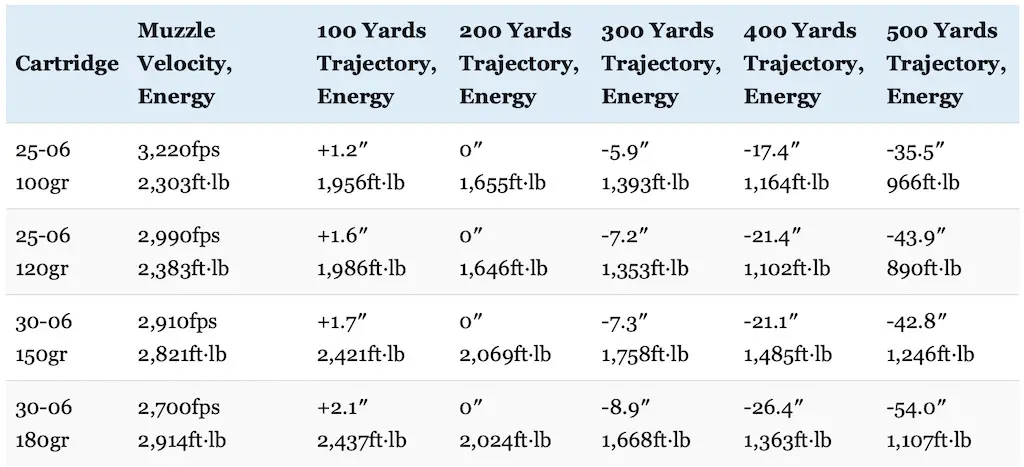
As you can see, the 25-06 Remington has a flatter trajectory while the 30-06 has more kinetic energy at all ranges.
This is due to the fact that the 25-06 fires lighter and smaller bullets at a significantly higher velocity than the 30-06 Springfield.
The details matter here though and there’s a bit of overlap with their performance, especially when you compare the more aerodynamic and higher velocity Ballistic Tip loads to the Core Lokt loads.
However, every 30-06 Springfield load has a little more muzzle energy and a more arching trajectory than the comparable 25-06 load with the same bullet primarily due to the fact that the 25-06 shoots a lighter bullet about 300fps faster than the 30-06 does with the same bullet type.
On the whole, the various 30-06 loads have about 18-27% more muzzle energy and 15-40% more retained energy at 500 yards.
The 150gr 30-06 Ballistic Tip load actually has a very similar trajectory to the 120gr 25-06 Core Lokt load. Their muzzle velocities are very similar so they track very closely until that 30-06 load surpasses the 25-06 between 300 and 400 yards and has about 1″ less bullet drop at 500 yards.
Here’s how each 30-06 load compares individually to the comparable 25-06 load in terms of muzzle energy, retained energy at 500 yards, and bullet drop at 500 yards:
Nosler Ballistic Tip: the 30-06 has 22.5% more muzzle energy, 29% more kinetic energy at 500 yards, and 7.3″ (20.5%) more bullet drop at 500 yards.
Remington Core Lokt: the 30-06 has 22.2% more muzzle energy, 24.3% more kinetic energy at 500 yards, and 10.1″ (23%) more bullet drop at 500 yards.
Additionally, all the 25-06 loads in this comparison easily maintain at least 1,000 ft-lbs of energy out past 400 yards and all the 30-06 loads stay above that energy threshold past 500 yards.
At the same time, both 30-06 loads carry 1,500ft-lbs of kinetic energy out past 300 yards while the 25-06 loads dip below 1,500ft-lbs of energy between 200 and 300 yards.
So, the big takeaways so far are that the 25-06 is generally a flatter shooting cartridge while the 30-06 is a harder hitting cartridge.
That’s shouldn’t be surprising because we’re comparing a larger bore cartridge shooting heavier and often more aerodynamic bullets to a necked down version of that same cartridge shooting lighter and smaller diameter bullets at a higher velocity.
The chart below compares how much a 10 mile per hour crosswind impacts those same 25-06 Remington and 30-06 loads out to 500 yards.
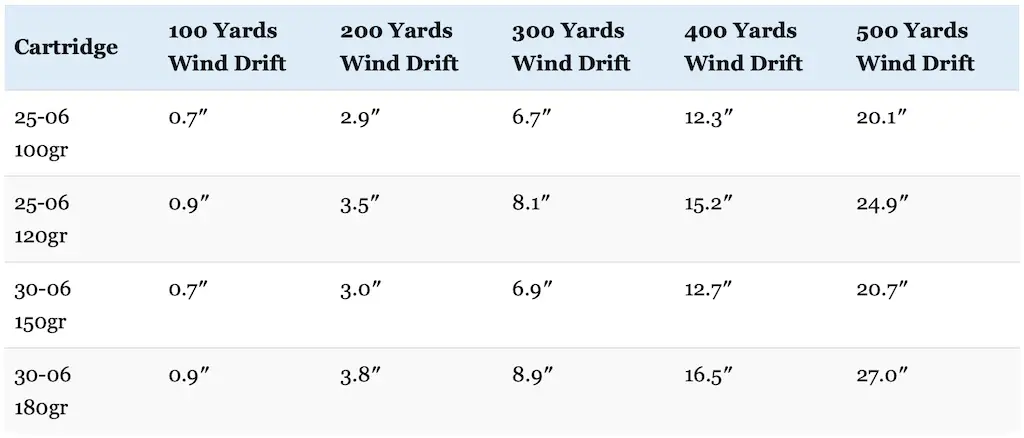
Interestingly, things are a little different in this area.
The 25-06 does have an advantage overall, but that’s exclusively due to the higher muzzle velocity of those loads. The 30-06 does have the edge with ballistic coefficient, which is very important with wind deflection.
With that in mind, the 150gr 30-06 load actually has quite a bit less wind deflection than the 120gr 25-06 load. The various 30-06 loads will either track the 25-06 very closely or even close the gap in wind deflection to a certain degree.
Here’s the breakdown by loading for wind drift at 300 yards and 500 yards:
Ballistic Tip: the 30-06 has .2″ (2.9%) more wind deflection at 300 yards and .6″ (2.9%) more wind deflection at 500 yards.
Remington Core Lokt: the 30-06 has .8″ (9.8%) more wind deflection at 300 yards and 2.1″ (8.4%) more wind deflection at 500 yards.
External ballistics don’t tell the whole story though and there’s more to picking a hunting cartridge than kinetic energy, bullet drop, or wind drift at various ranges.
For instance, now let’s talk about recoil.
The table below compares the recoil produced by handloads that approximate the performance of the Remington factory loads above firing 120gr and 180gr bullets for the 25-06 Remington and 30-06 Springfield respectively when fired from identical 7 pound rifles.
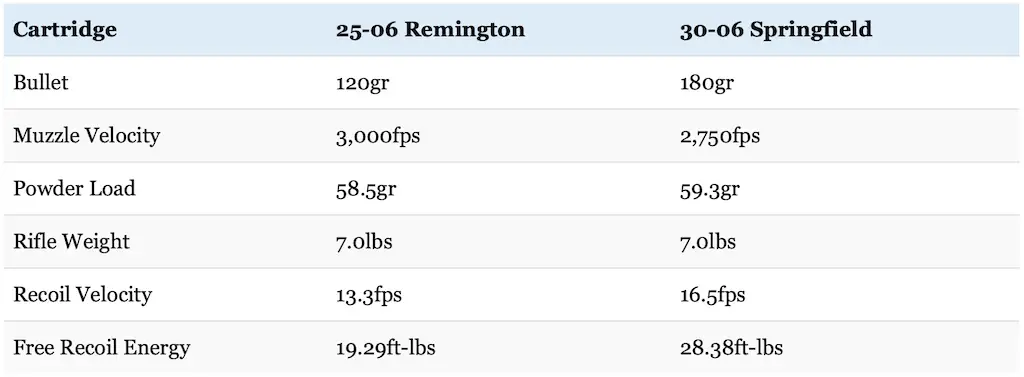
Felt recoil will vary from shooter to shooter and rifle to rifle, but free recoil energy is still a useful way to compare cartridges.
As you can see, the 30-06 has about 47% more recoil than the 25-06!
All things considered, the 30-06 isn’t that hard of a recoiling cartridge. Indeed, it’s known as one of the more “shootable” serious big game hunting cartridges and most hunters should be able to handle that recoil without serious trouble.
The 25-06 just has even less recoil though and has an advantage in this respect, especially for smaller or recoil shy hunters.
Don’t underestimate the impact that recoil has on the ability of a person to shoot accurately either.
Some people do handle recoil better than others, but all other things being equal, they will absolutely shoot more accurately with a milder recoiling cartridge.
Additionally, there are a couple of other factors that are also worth discussing.
First, the 30-06 Springfield uses larger diameter bullets than the 25-06 Remington.
Specifically, the larger diameter .308 bullets used by the cartridge have about 44% more frontal surface area (also known as cross sectional area) than the .257″ bullets used by the 25-06 Remington (.0745 vs .0519 square inches). All other things being equal, a bigger bullet will make a bigger hole, cause more tissue damage, and result in more blood loss.
This is a significant advantage in favor of the 30-06, especially on bigger game.

Especially when combined with the fact that the 30-06 carries more kinetic energy downrange, those larger diameter bullets can also be helpful when hunting big game, especially on really big game like elk.
At the same time, the 30-06 also has a slight edge over the 25-06 in bullet sectional density.
Sectional density (SD) is a measure of the ratio of the diameter of a projectile to its mass.
All other things equal, a heavier bullet of a given caliber will be longer and therefore have a higher sectional density and consequently penetrate deeper than projectiles with a lower mass and sectional density.
As an example, 90 grain, 100 grain, 110 grain, and 120 grain .257″ bullets have sectional densities of .195, .216, .238, and .260 respectively.
Compare that to 150 grain, 165 grain, 180 grain, and 200 grain .308″ bullets which have sectional densities of .226, .248, .271, and .301 respectively.
This is something of a mixed bag on the face of things.
The heaviest 120gr .25 caliber bullets outclass the lighter 150gr and 165gr .30 caliber bullets, but the 30-06 has the edge overall. That’s especially true when comparing the most popular bullet weights for each cartridge as well as with the heaviest stuff available in both cartridges.
This also applies to ballistic coefficient.
Quarter bore cartridges like the 25-06 suffer from a lack of really high ballistic coefficient bullets. This is due in large part to the fact that rifles with that bore diameter (like the 257 Roberts, 25-06, and 257 Weatherby Magnum) typically use a 1:10″ rifling twist rate.
That twist rate is unfortunately not fast enough to stabilize bullets heavier than about 120 grains or bullets with a really sleek profile heavier than about 110 grains.
For that reason, the major bullet manufacturers have not invested a lot of time developing heavy for caliber, high BC .257″ bullets.
The 30-06 does not suffer from this problem.
For instance, the bullets used in this comparison illustrate those differences well with the 25-06 using 100gr (.394 BC) and 120gr (.362 BC) bullets that are outclassed by the 150gr (.434 BC) and 180gr (.383 BC) bullets used by the .30-06.
Hornady’s .25 caliber 110gr ELD-X used in their Precision Hunter Line has a .465 G1 BC and that’s about as good as it gets for that chambering in a factory load right now. Nosler also offers a 110gr AccuBond bullet with a .418 BC that’s also pretty good.
However, there are LOTS of higher BC options for the 30-06 available in factory loads like the 168gr Nosler AccuBond Long Range (.525 BC), the 178gr ELD-X (.552 BC), and the 180gr Nosler AccuBond (.507 BC).
So where do we stand with each cartridge?
25-06 vs 30-06
The 30-06 Springfield fires a larger diameter, often heavier, and usually more aerodynamic bullet at a slower velocity than the 25-06 Remington. The 25-06 usually has a flatter trajectory, but the 30-06 typically has more retained kinetic energy and significantly more recoil than the 25-06.
30-06 vs 25-06 Ammo
While the 25-06 Remington is by no means a rare cartridge, the 30-06 Springfield is significantly more popular among hunters and shooters all over the world. Indeed, the 30-06 is certainly in the Top 10 most popular centerfire rifle cartridges in the United States (likely even in the Top 5).
While the 25-06 Remington is a fairly popular cartridge itself, but the 30-06 is easily the most widely used of the two.
The big ammunition manufacturers like Barnes, Federal Premium, Fiocchi, Hornady, HSM, Nosler, Prvi Partizan, Remington, and Winchester all produce 25-06 factory ammunition suitable for hunting most species of big game.
However, basically every company that manufactures rifle ammo also produces 30-06 factory ammo as well. So, it’s usually available in all the lines the 25-06 is made in, plus a few extras.
For instance, the 25-06 is offered in most of the really popular hunting ammo lines: Barnes VOR-TX, Federal Fusion, Federal Power Shok, Hornady Precision Hunter, Hornady Superformance, Hornady American Whitetail, Nosler Trophy Grade, Nosler Ballistic Tip, Remington Core Lokt, Winchester Deer Season XP, and Winchester Super X (among others).
At the same time, the 30-06 is available in all of those lines plus a few others the 25-06 is not available in like Barnes VOR-TX Long Range, Federal Terminal Ascent, Federal Non-Typical, Hornady Outfitter, Hornady Custom Lite, Nosler Trophy Grade Long Range, Winchester Power Max Bonded, and Winchester Expedition Big Game.
While it’s often easy to find a variety of ammo for both cartridges during normal times, ammo is usually a little easier to find and there will be a larger selection to choose from for the 30-06. In general, 30-06 ammo is often a little less expensive.
During the 2020-2022 ammo shortage, the difference between the two cartridges has become even more apparent and (at least where I live and shop) 30-06 Springfield ammo is usually easier to find and usually more reasonably priced than ammo for the 25-06 Remington.
Ammo availability is also usually decent online and the bigger retailers typically have a good selection of quality factory ammo for both cartridges as well (but the 30-06 will likely still be easier to find and less expensive, even online).
Bottom line: the average hunter will likely have easier access to ammo for the 30-06 Springfield than the 25-06 Remington.
BUY SOME EXCELLENT 25-06 AMMO HERE
BUY SOME GREAT 30-06 AMMO HERE
If you’d like to learn more about some of the various hunting ammunition choices for the 30-06 cartridge, read this article:
Best 30-06 Ammo For Hunting Elk, Deer, Bear, Hogs, & Other Game
Handloaders will appreciate the fact that reloading components for both cartridges are available and there’s an excellent variety of bullet choices for each cartridge. This is especially true for the 30-06. So, you should not have any trouble working up a good custom load for either one if you like to handload.
The 25-06 Remington uses the same .257″ bullet size as the 250 Savage, .257 Roberts, and .257 Weatherby,
The .30-06 Springfield uses the same .308″ bullet size as the .308 Winchester/7.62x51mm NATO, .30-30 Winchester, .300 Win Mag, 300 WSM, .300 Ultra Mag, and .300 PRC.
30-06 vs 25-06 Rifles
Once again, the 30-06 Springfield is usually more common than the 25-06 Remington when it comes to rifle selection. However, there’s a decent selection of rifles chambered in both cartridges.
Both cartridges are really common in bolt-action rifles.
For instance, both the 25-06 and the 30-06 are available in several different versions of the Remington Model 700 and Winchester Model 70. The same goes for the Browning X-Bolt, Mossberg Patriot, Ruger American, Savage Axis, Savage 110, Weatherby Vanguard, and Weatherby Mark V.
While both rifles are most common in bolt-action rifles, they’re also available in a few lever-action and semi-automatic models as well.
Both cartridges are available from Browning in their Browning Automatic Rifles (BAR) and the 30-06 (but not the 25-06) is available in the Browning Lever Action Rifle (BLR).
So, you can probably find a good deer rifle available in either cartridge regardless of the action type you prefer.
The 30-06 is once again the most popular, most common, and easiest to find of the two though.
BUY AN EXCELLENT 30-06 RIFLE HERE
25-06 vs 30-06: Which Is Right For You?
Do you primarily hunt medium sized game like whitetail deer and feral hogs at ranges within 200 yards? Both the 25-06 Remington and 30-06 Springfield are outstanding deer hunting cartridges and will work on great deer sized game with good shot placement.
The 25-06 in particular (especially with 100-grain bullets) is one of those “classic” deer hunting cartridges and really shines in that role. In fact, I’d recommend the 25-06 Remington for someone who was primarily interested in hunting deer.
Are you looking for the cartridge better suited for long range hunting for game like mule deer or pronghorn antelope in open country where you might need to take a shot at longer ranges? Once again, both will work really well here overall.
The flat shooting 25-06 Remington shines in this area compared to a lot of other cartridges. Indeed, this was considered by many (to include guys like Craig Boddington and Ron Spomer) to be the quintessential pronghorn hunting cartridge for many years.
I think there are better options available for dealing with the windy conditions often encountered while pronghorn hunting these days (like the much newer 6.5 PRC), but the 25-06 is still a darn good choice for those hunts.
Do you want a hunting cartridge that’s well suited for black bear, caribou, moose, elk, eland, kudu, or red stag hunting? The 25-06 Remington will certainly work on bigger game. However, of the two cartridges though, I strongly recommend the 30-06 because it uses larger diameter and heavier bullets with a bigger sectional density that tend to penetrate a little better.
Loaded with something like a quality 180gr Partition, AccuBond, or A-Frame, a 168gr AccuBond Long Range, or a 180gr lead free bullet (like the Barnes TSX/TTSX), the 30-06 is a fantastic choice for use on larger animals at reasonable ranges.
While I think the 25-06 Remington is potentially the better choice for someone who exclusively (or even primarily) hunts for deer, I think the 30-06 Springfield is a better option for someone primarily hunting elk or moose.
Especially when using premium bullets, the 30-06 is actually one of the most flexible cartridges available and is an ideal choice for a person who wants to hunt the widest variety of game possible with a single cartridge.
Are you specifically hunting brown or grizzly bear? What if you hunt in Canada or Alaska and need a heavy hitting cartridge just in case you find yourself on the wrong end of a grizzly/brown bear attack? Neither would be my first choice for use on those hunts. That said, they will definitely work in a pinch. Of the two, I’d go with the 30-06 since it uses larger diameter and heavier bullets. Make sure you use premium, heavy for caliber 180gr or heavier bullets more likely to deliver really deep penetration if you go that route.
For what it’s worth, Roy Lindsley used a .30-06 Springfield to take the current Boone & Crockett record Alaska brown bear back in 1952. That said, he shot that bear years before cartridges like the 7mm Remington Magnum, .300 Winchester Magnum, and .338 Winchester Magnum even existed.
Are you sensitive to recoil and in need of a lower recoil cartridge? Neither has terrible recoil, but the 25-06 Remington definitely has mild recoil (even with a lighter rifle weight) that gives it the edge over the 30-06.
Are you looking for a great cartridge for sheep, mountain goat, or tahr hunting where you need an effective cartridge with manageable recoil in a lightweight and easy to carry rifle? The 25-06 will certainly work, but I’d prefer the 30-06. Sheep hunts are so unique and often so physically demanding that I’d go with something with more power that also bucks the wind a little better to expand my shot window.
Ideally, I’d get to use something a little more modern (like one of the fast 6.5 mm cartridges), but I’d take the 30-06 loaded with a very high BC bullet (like the 178gr ELD-X) over the 25-06 for this hunting situation.
As I’ve stated before: the 25-06 Remington and 30-06 Springfield are both solid rifle cartridges. However, while there’s a lot of overlap in their performance and ideal uses, there are some significant differences between them (25-06 vs 30-06) in certain respects and each cartridge is better suited to specific situations than the other.
Carefully evaluate your needs as a hunter based upon the circumstances you foresee using the cartridge in, get a good hunting rifle chambered in the cartridge you select, learn to shoot it well, use quality bullets, and it should serve you well afield.
NEXT: BEST 6.5 CREEDMOOR AMMO FOR HUNTING ELK, DEER, & OTHER BIG GAME
NEXT: BEST GIFTS FOR HUNTERS
Enjoy this article comparing the 25-06 Remington and 30-06 Springfield cartridges? Please share it with your friends on Facebook and Twitter.
The Lyman 50th Edition (p175-176 and p246-250) and Hornady 10th Edition (p276-280 and p510-522) reloading manuals were used as references for the history of the 25-06 vs 30-06 cartridges. I obtained the data used to compare the trajectory of the cartridges from Federal (here and here) and Remington (here and here). Data used to calculate recoil was obtained from the Hornady 10th reloading manual (p280 & p515). Case capacity information for the 25-06 Remington and 30-06 Springfield were obtained from Chuck Hawks (here). Maximum pressure and data to compare cartridge sizes for the 25-06 Remington and 30-06 Springfield were obtained from SAAMI (p27 and p29). I used ShootersCalculator.com to compare trajectory and recoil for the cartridges.
Make sure you subscribe to The Big Game Hunting Podcast and follow The Big Game Hunting Blog on Facebook, Instagram, Twitter, and YouTube.
John McAdams is a proficient blogger, experienced shooter, and long time hunter who has pursued big game in 8 different countries on 3 separate continents. John graduated from the United States Military Academy at West Point and is a veteran of combat tours with the US Army in Iraq & Afghanistan. In addition to founding and writing for The Big Game Hunting Blog, John has written for outdoor publications like Bear Hunting Magazine, The Texas State Rifle Association newsletter, Texas Wildlife Magazine, & Wide Open Spaces. Learn more about John here, read some of John’s most popular articles, and be sure to subscribe to his show: the Big Game Hunting Podcast.


I do believe there’s a typo: “However, while the .30-06 has a slightly longer overall length (3.34″ vs 3.25″), they are close enough in size that both cartridges are used in standard/long-action rifles.” shouldn’t it read ” … the 25-06 has a slightly longer overall length …”
That’s not a typo, but it is a point in need of clarification and I appreciate you pointing it out. I just corrected that paragraph to read: “Though the .30-06 Springfield cartridge in the photo is slightly shorter than the .25-06 cartridge, the 30-06 actually has a longer SAAMI maximum authorized overall length of 3.34″ (84.84mm) vs just 3.25″ (82.6mm) for the 25-06.
However, the two cartridges are close enough in size that both cartridges are used in standard/long-action rifles.”
Hope that makes more sense!